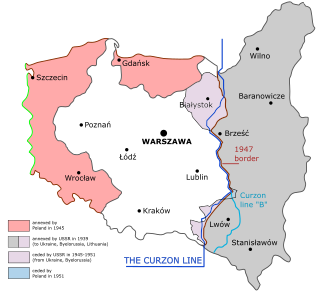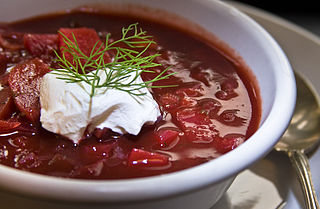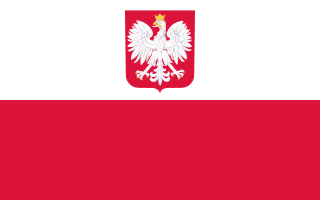Knödel or Klöße are boiled dumplings commonly found in Central European and East European cuisine. Countries in which their variant of Knödel is popular include Austria, Germany, Hungary, Poland, Romania, Bosnia, Croatia, Serbia, Slovenia, Slovakia, and the Czech Republic. They are also found in Scandinavian, Romanian, northeastern Italian cuisine, Ukrainian, Belarusian and French (Alsatian) cuisines. Usually made from flour, bread or potatoes, they are often served as a side dish, but can also be a dessert such as plum dumplings, or even meat balls in soup. Many varieties and variations exist.

Potato pancakes are shallow-fried pancakes of grated or ground potato, matzo meal or flour and a binding ingredient such as egg or applesauce, often flavored with grated garlic or onion and seasonings. They may be topped with a variety of condiments, ranging from the savory, to the sweet, or they may be served plain. The dish is sometimes made from mashed potatoes to make pancake-shaped croquettes. Some variations are made with sweet potatoes.

Pączki are filled doughnuts found in Polish cuisine.

Polish cuisine is a style of food preparation originating in and widely popular in Poland. Due to Poland's history, Polish cuisine has evolved over the centuries to be very eclectic, and shares many similarities with other national cuisines. Polish cooking in other cultures is often referred to as à la polonaise.

Pierogi or Pierogies are filled dumplings, made by wrapping unleavened dough around a filling, and occasionally flavored with a savory or sweet garnish and cooking in boiling water.
European cuisine comprises the cuisines that originate from the various countries of Europe.

Eastern Borderlands or simply Borderlands was a term coined for the eastern part of the Second Polish Republic during the interwar period (1918–1939). Largely agricultural and extensively multi-ethnic with a Polish minority, it amounted to nearly half of the territory of interwar Poland. Historically situated in the eastern Polish–Lithuanian Commonwealth, following the 18th-century foreign partitions it was divided between the Empires of Russia and Austria-Hungary, and ceded to Poland in 1921 after the Treaty of Riga. As a result of the post-World War II border changes, all of the territory was ceded to the USSR, and none of it is in modern Poland.

Eastern European cuisine encompasses many different cultures, ethnicities, languages, and histories of Eastern Europe.

Kalduny or kolduny are potato pancakes with meat or, nowadays much less often, pelmeni made in Belarusian, Lithuanian, and Polish cuisines, akin to the Polish pierogi, Russian pelmeni and the Ukrainian varenyky.

Belarusian cuisine refers to the culinary traditions native to Belarus. It shares many similarities with cuisines of other Eastern, Central and Northeastern European countries, based predominantly on meat and various vegetables typical for the region.

Smetana is the English-language name for the types of sour cream traditionally prevalent in Central, Eastern, and Southeastern Europe. It is a dairy product produced by souring heavy cream. It is similar to crème fraîche, but nowadays mainly sold with 9% to 42% milkfat content depending on the country. Its cooking properties are different from crème fraîche and the lighter sour creams sold in the US, which contain 12 to 16% butterfat. It is widely used in cooking and baking.

Šakotis is a Polish, Lithuanian and Belarusian traditional spit cake, similar to the German Baumkuchen. It is a cake made of butter, egg whites and yolks, flour, sugar, and cream, cooked on a rotating spit in an oven or over an open fire.

Sorrel soup is made from water or broth, sorrel leaves, and salt. Varieties of the same soup include spinach, garden orache, chard, nettle, and occasionally dandelion, goutweed or ramsons, together with or instead of sorrel. It is known in Ashkenazi Jewish, Belarusian, Estonian, Hungarian, Latvian, Lithuanian, Romanian, Armenian, Polish, Russian and Ukrainian cuisines. Its other English names, spelled variously schav, shchav, shav, or shtshav, are borrowed from the Yiddish language, which in turn derives from Slavic languages, like for example Belarusian шчаўе, Russian and Ukrainian щавель, shchavel, Polish szczaw. The soups name comes ultimately from the Proto-Slavic ščаvь for sorrel. Due to its commonness as a soup in Eastern European cuisines, it is often called green borscht, as a cousin of the standard, reddish-purple beetroot borscht. In Russia, where shchi has been the staple soup, sorrel soup is also called green shchi. In old Russian cookbooks it was called simply green soup.

Bublik is a traditional Eastern European bread roll. Like a bagel, it is a ring of yeast-leavened wheat dough, that has been boiled in water for a short time before baking.

The poppy seed roll is a pastry consisting of a roll of sweet yeast bread with a dense, rich, bittersweet filling of poppy seed. An alternative filling is a paste of minced walnuts, or minced chestnuts.

A Polonophile is an individual who respects and is fond of Poland's culture as well as Polish history, traditions and customs. The term defining this kind of attitude is Polonophilia. The antonym and opposite of Polonophilia is Polonophobia.

Ashkenazi Jewish cuisine is an assortment of cooking traditions that was developed by the Ashkenazi Jews of Central, Eastern and Northern Europe, and their descendants, particularly in the United States and other Western countries.















































